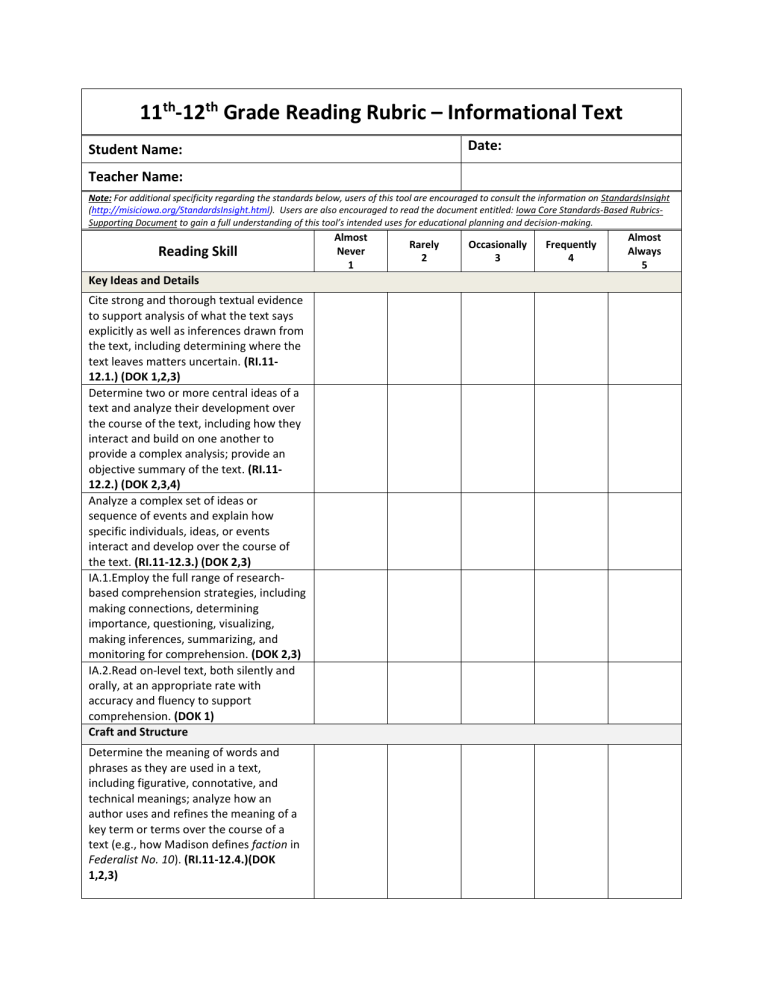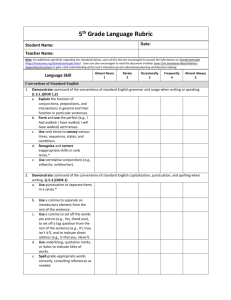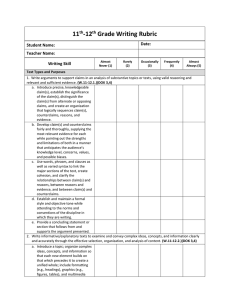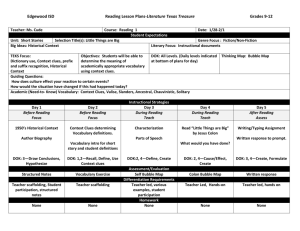11th-12th Grade - IC Informational Text

11
th
-12
th
Grade Reading Rubric – Informational Text
Student Name:
Date:
Teacher Name:
Note: For additional specificity regarding the standards below, users of this tool are encouraged to consult the information on StandardsInsight
( http://misiciowa.org/StandardsInsight.html
). Users are also encouraged to read the document entitled: Iowa Core Standards-Based Rubrics-
Supporting Document to gain a full understanding of this tool’s intended uses for educational planning and decision-making.
Reading Skill
Almost
Never
1
Rarely
2
Occasionally
3
Frequently
4
Almost
Always
5
Key Ideas and Details
Cite strong and thorough textual evidence to support analysis of what the text says explicitly as well as inferences drawn from the text, including determining where the text leaves matters uncertain. (RI.11-
12.1.) (DOK 1,2,3)
Determine two or more central ideas of a text and analyze their development over the course of the text, including how they interact and build on one another to provide a complex analysis; provide an objective summary of the text. (RI.11-
12.2.) (DOK 2,3,4)
Analyze a complex set of ideas or sequence of events and explain how specific individuals, ideas, or events interact and develop over the course of the text. (RI.11-12.3.) (DOK 2,3)
IA.1.Employ the full range of researchbased comprehension strategies, including making connections, determining importance, questioning, visualizing, making inferences, summarizing, and monitoring for comprehension. (DOK 2,3)
IA.2.Read on-level text, both silently and orally, at an appropriate rate with accuracy and fluency to support comprehension. (DOK 1)
Craft and Structure
Determine the meaning of words and phrases as they are used in a text, including figurative, connotative, and technical meanings; analyze how an author uses and refines the meaning of a key term or terms over the course of a text (e.g., how Madison defines faction in
Federalist No. 10). (RI.11-12.4.)(DOK
1,2,3)
Analyze and evaluate the effectiveness of the structure an author uses in his or her exposition or argument, including whether the structure makes points clear, convincing, and engaging. (RI.11-12.5.)
(DOK 2,3,4)
Determine an author’s point of view or purpose in a text in which the rhetoric is particularly effective, analyzing how style and content contribute to the power, persuasiveness, or beauty of the text.
(RI.11-12.6.) (DOK 2,3,4)
Integration of Knowledge and Ideas
Integrate and evaluate multiple sources of information presented in different media or formats (e.g., visually, quantitatively) as well as in words in order to address a question or solve a problem. (RI.11-12.7.)
(DOK 3,4)
Delineate and evaluate the reasoning in seminal U.S. texts, including the application of constitutional principles and use of legal reasoning (e.g., in U.S.
Supreme Court majority opinions and dissents) and the premises, purposes, and arguments in works of public advocacy
(e.g., The Federalist, presidential addresses). (RI.11-12.8.) (DOK 2,3,4)
Analyze seventeenth-, eighteenth-, and nineteenth-century foundational U.S. documents of historical and literary significance (including The Declaration of
Independence, the Preamble to the
Constitution, the Bill of Rights, and
Lincoln’s Second Inaugural Address) for their themes, purposes, and rhetorical features. (RI.11-12.9.) (DOK 2,3)
Range of Reading and Level of Text Complexity
By the end of grade 11, read and comprehend literary nonfiction in the grades 11–CCR text complexity band proficiently, with scaffolding as needed at the high end of the range.
By the end of grade 12, read and comprehend literary nonfiction at the high end of the grades 11–CCR text complexity band independently and proficiently.
(RI.11-12.10.) (DOK 1,2)
*Rating Descriptors Operationally Defined:
Almost Never – grade level standard/skill is demonstrated/observed very little or not at all (with appropriate accommodations) with no generalization of skill across days and novel tasks.
Rarely – grade level standard/skill is demonstrated/observed infrequently (with appropriate accommodations) with little or no generalization of skill across days and novel tasks; teacher prompting does not always result in demonstration of skill.
Occasionally – grade level standard/skill is demonstrated/observed periodically (with appropriate accommodations) with inconsistent generalization across days and novel tasks; teacher prompting is often necessary for skill to be generalized.
Frequently – grade level standard/skill is demonstrated/observed often (with appropriate accommodations) with consistent generalization of skill across days and novel tasks; occasional teacher prompting is necessary for skill to be generalized.
Almost Always – grade level standard/skill is demonstrated/observed most of the time (with appropriate accommodations) with consistent and independent generalization of skill across days and novel tasks.
Place calendar date next to the numeral to signify date of data summary, and a listing of utilized data sources, summary and next steps in the appropriate spaces
Date #1:
Date #2:
Summary:
Next Steps:
Date #3:
Summary:
Next Steps:
Date #4:
Summary:
Next Steps:
Date #5:
Summary:
Next Steps:
Baseline Data Sources
Data Sources:
Data Sources:
Data Sources:
Data Sources:
Data Sources: Date #6:
Summary:
Next Steps:
Date #7:
Summary:
Next Steps:
Date #8:
Summary:
Next Steps:
Date #9:
Summary:
Next Steps:
Data Sources:
Data Sources:
Data Sources:
Data Sources: Date #10:
Summary
Next Steps:
Date #11:
Summary:
Next Steps:
Data Sources:
Date #12:
Summary:
Next Steps:
Date #13:
Summary:
Next Steps:
Date #14:
Summary:
Next Steps:
Date #15:
Summary:
Next Steps:
Date #16:
Summary:
Next Steps:
Date #17:
Summary:
Next Steps:
Date #18:
Summary:
Next Steps:
Data Sources:
Data Sources:
Data Sources:
Data Sources:
Data Sources:
Data Sources:
Data Sources:










